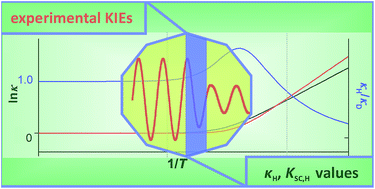What are the signatures of tunnelling in enzyme-catalysed reactions?†
Abstract
While it is well established that thermally-activated quantum mechanical tunnelling of light particles (electrons and light atoms, typically hydrogen) plays a role in many enzyme-catalysed reactions, there are few definitive experimental signatures of atomic tunnelling and no clear methods of directly estimating the relative tunnelling contribution from typical experimental data. As most enzyme reactions involve the binding/capture of freely diffusing substrate(s), reactions are typically initiated by mixing and experimental conditions must then be compatible with liquid water (the solvent). This precludes the classic test of tunnelling: the observation of temperature-independent rate constants at cryogenic temperatures. Instead, H-tunnelling is usually inferred from kinetic isotope effects that are larger than the semiclassical limit. Often, the temperature dependence of the reaction is also measured over the experimentally accessible range (∼278–313 K for mesophilic enzymes), with resulting data analysed and interpreted using variations of Arrhenius, Eyring or Marcus theory. The apparent Arrhenius and Eyring activation parameters allow some quantitative comparison of different reactions, but do not directly provide any information about tunnelling, while the validity of parameters derived from non-adiabatic models such as Marcus theory are questionable due to the partially adiabatic nature of these reactions. Here, we use the correlation found between apparent activation enthalpy and entropy across several series of enzyme variants and tunnelling contributions determined using computational chemistry in an attempt to question and define new signatures of hydrogen tunnelling, which can be used to interpret typical experimental kinetic data measured for enzyme-catalysed reactions.

- This article is part of the themed collection: Quantum effects in complex systems


 Please wait while we load your content...
Please wait while we load your content...